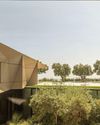
Arriving in Ho Chi Minh City for the first time can feel like a shock to the system. Decades ago, you might have spotted bicycles wobbling through lantern-lit streets and buffaloes basking in opaque waters, but today, the modern metropolis is rather different.
As your taxi crawls through the periphery, besieged by motorbikes, you'll encounter few cyclists and no fauna (save, perhaps, the odd pocket poodle). Instead, you'll cruise through hyperactive streets flanked by terraced houses with ground-floor neon shops. Occasionally, a glass-clad office or hotel will interrupt the carnival of mismatched nha ong or 'tube houses'.
These skinny buildings, which can be less than 3m wide and up to 12 floors tall, have popped up all around Vietnam as a result of limited building space and property tax policies. The only design consistency seems to be deliberate inconsistency; after all, Ho Chi Minh City is a city that pushes you to stand out.
Within Ho Chi Minh City's historic core, a sense of order emerges. In the early years of the colonial period (1862-1954), the French flattened much of the old city, founded around 400 years ago, and laid down a grid system that still gives structure to the city centre. Here you'll find the city's more storied architecture, such as the early 20th-century Jade Emperor Pagoda, a labyrinthine temple guarded by magenta walls, or Villa Le Voile, a flamboyant French mansion that is being turned into a cultural centre with help from restoration specialists Stonewest of London and Palazzo Spinelli of Florence.
Nearby is local architect Ngo Viet Thu's Independence Palace, completed in 1966 to replace a bombed French behemoth and now considered a paragon of Vietnam's postcolonial modernism. The style, a branch of tropical modernism, borrowed minimalist design ideas from elsewhere in the world and adapted them to suit Vietnam's heat and humidity.
Esta historia es de la edición June 2024 de Wallpaper.
Comience su prueba gratuita de Magzter GOLD de 7 días para acceder a miles de historias premium seleccionadas y a más de 9,000 revistas y periódicos.
Ya eres suscriptor ? Conectar
Esta historia es de la edición June 2024 de Wallpaper.
Comience su prueba gratuita de Magzter GOLD de 7 días para acceder a miles de historias premium seleccionadas y a más de 9,000 revistas y periódicos.
Ya eres suscriptor? Conectar

COOL RUNNINGS
Palace founder Lev Tanju is bringing his own unexpected brand of weirdness and love of eclectic mash-ups to Fila's new contemporary line

LIVING COLOUR
Mexico's San Miguel de Allende is home to a bold young crowd of talent that's thriving off the city's brightly-hued heritage

STARS ASCENDING
In a rapidly changing world, the route designers take to discover their calling is increasingly circuitous. We profile ten creatives forging their own paths to success

SUITE DREAMS
Cathay Pacific’s new aircraft interiors turn the inflight experience into an art form, upgrading the business-class cabin for the next generation of flyers

Brutal harmony
The Escheresque Italian villa designed by Fausto Bontempi for sculptor Claudio Caffetto

LOCAL HERO
London studio Holloway Li’s recent makeover of Polish hotel Puro Poznan is right up our street

STAR TURNS
An exhibition at Louvre Abu Dhabi unveils the stellar shortlist for this year's Richard Mille Art Prize

SCREEN GEM
A multifaceted residence in Beverly Hills puts the beauty of potentiality in the frame

SOFT SPOT
We've taken a shine to Bottega Veneta's collaboration with Flos on a special edition of a Gino Sarfatti lamp

Between the lines
Frequently drawing comparisons with Francis Bacon, painter George Rouy is gaining peer points for his use of classic techniques to distort the human form